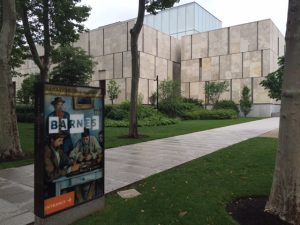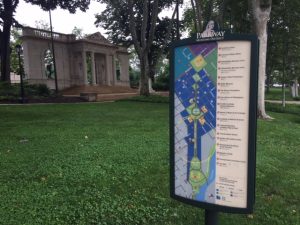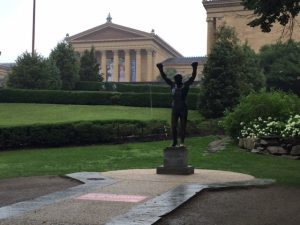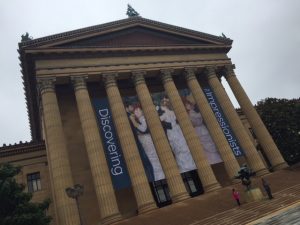To most, the name “Philadelphia” is synonymous with Rocky Balboa, the Liberty Bell, and soft pretzels. But the cradle of American democracy boasts more than its well-known slew of historic landmarks and pop culture references – it is also home to a large number of world class art museums, complete with its very own Avenue des Champs-Élysées leading from City Hall to what is, arguably, the crown jewel in the city’s collection: The Philadelphia Museum of Art.
But before we talk about the PMA, let’s start with a few other sites not to be missed. Heading northwest from the city center along Benjamin Franklin Parkway, you’ll pass Logan Square (an architectural delight itself) before coming to the new (if controversial) home of the Barnes Foundation. Established by Dr. Albert C. Barnes in 1922 to “promote the advancement of education and the appreciation of the fine arts and horticulture” the collection was originally housed on the Barnes estate in Merion before it was brought to Philadelphia in 2012.

Barnes was a successful entrepreneur (his greatest accomplishment being the creation of an antiseptic silver compound used in the prevention of infant blindness called Argyrol with Herman Hille) and began collecting art for its educational value. He provided his employees with numerous lectures and educational workshops and evidently enjoyed refusing the requests of more “serious” art scholars to view his collection.
What makes the Barnes collection unique, however, is its arrangement. Rejecting conventional curatorial techniques, Barnes decided not to arrange his works of art by chronology or geography but rather by subject matter and form. His original assemblages, therefore, eschewed the traditional divisions between “fine” and “decorative” or “folk” arts, and the new museum preserves this democratic spirit. The building, designed by Tod Williams and Billie Tsien, also echoes the emphasis Barnes placed on education, nature and aesthetics; the many of the galleries are filled with natural light and surrounded by beautiful gardens.
Just a few steps away is celebrated Rodin Museum, which houses one of the world’s largest collections of the 19th-century French sculptor Auguste Rodin, including his masterwork, The Gates of Hell. Like The Barnes, the Rodin Museum boasts impressive gardens, which were created by French landscape designer Jacques Gréber, and its Beaux-Arts architecture, by Frenchman Paul Cret, provides an intimate backdrop for escaping the hustle and bustle of the city to enjoy the work of the famous sculptor. Just bear in mind while planning your trip that both the Barnes and the Rodin are closed on Tuesdays.

Poised atop the end of the Benjamin Franklin Parkway is the Philadelphia Museum of Art. You’ll know you’re almost there when you reach “The Oval,” a new community space at the edge of the Benjamin Franklin Parkway that features live music, movie nights, workshops, a beer garden and even a rotating lineup of food trucks during summer months.
You can pause to take your photograph beside the famed Rocky statue, which was cast in bronze for Rocky III and donated to the city by Sylvester Stallone, or reenact his famous ascent up what have come be known as “the Rocky steps.” (You can also just park in the new garage behind the museum or take a shuttle bus, which drops you off at the top and also offers access to the nearby Perelman Building, where additional galleries are housed, in addition to many other cultural attractions). Just keep in mind that unlike the Barnes and the Rodin, the PMA is closed on Mondays instead of Tuesdays.

The museum got its start during the 1876 Centennial Exhibition, housed in nearby Fairmount Park. Its collections were moved to their current home in the 1920s and the museum remains a vibrant force in the city’s cultural fabric, offering everything from “Pay What You Can” Wednesday nights to live music and great eats through its “Art After 5” program on Fridays.
Its collection runs the gamut, with particular strengths in Impressionism and modern art, but some of its most interesting features comprise fully-reconstructed architectural marvels including a full-size Japanese tea house, an authentic medieval cloister (complete with a working fountain) and interiors collected and reinstalled from posh abodes throughout Europe and the United States. The museum also features a rotating exhibit space. Earlier this spring, visitors we able to witness the unprecedented Ink and Gold: Art of the Kano, which focused on the illustrious school of painting that got its start in 15th-century Japan during the age of the shogun.
The exhibition was the first of its kind outside of Japan (it was created in partnership with the Tokyo National Museum) and featured more than a hundred works of art ranging from folding screens decorated with gold leaf and sliding doors to scrolls and folding fans, which were given as diplomatic gifts and preserved hundreds of years ago for their historic and aesthetic importance. Because the works are so sensitive to light, they were shown through three different rotations and the museum developed a number of special programs to accompany the exhibit, ranging from an evening event focused on tattoos to a traditional Japanese tea ceremony.
This past weekend, a brand new exhibit opened, Discovering the Impressionists: Paul Durand-Ruel and the New Painting. Nowadays, Monet, Renoir, Pisarro and Degas are household names but when these important artists first began to depart from established modes of painting, their works were highly ridiculed and mocked by the French press. It was thanks to the foresight (and rather clever marketing techniques) of art dealer Durand-Ruel that their careers took off, giving birth the to Impressionist movement.

The exhibit marks the culmination of a partnership between the Philadelphia Museum of Art, the National Gallery in London and the Musée d’Orsay in Paris and features an impressive collection of paintings, many of which are seen together for the first time. It runs through September 13, with Philadelphia being the exhibit’s only American destination. Audiences across the country, however, can catch a glimpse of the exhibit during a film screening on Bastille Day (July 14th) when over 300 theaters will present Exhibition on Screen: The Impressionists and the Man Who Made Them.
That said, there’s nothing quite like the real thing, so if you’re looking for a great summer getaway, Philadelphia is the place to be.

